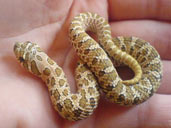 |
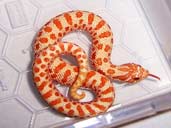 |
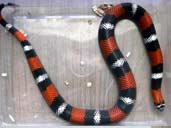 |
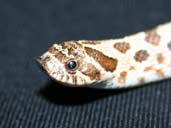 |
Western Hognose Heteroden nasicus |
Albino Western Hognose Heteroden nasicus |
Tri-Colour Hognose Lystrophis semicinctus |
Western Hognose Heteroden nasicus |
Hognose Snake Care Sheet
Common Name: Hognose Snake
Scientific Name: Heterodon
Other names commonly used: Blow Snake, Hissing Adder
The Hognose group of snakes are made up of three families, which are all closely related, but loosely divided up in relation to the location of their natural habitat. Here is a break down of the three generas:
Heterodon Hognose Snakes- native to the United States
Western Hognose- Heterodon nasicus
Eastern Hognose snake- Heterodon platirhinos
Southern Hognose snake- Heterodon simus
Leioheterodon Hognose Snakes- native to Madagascar
Malagasy Giant Hognose Snake- Leioheterodon madagascariensis
Speckled Hognose Snake- Leioheterodon geayi
Blonde Hognose Snake- Leioheteroden modestus
Lystrophis Hognose Snake- native to South America
Tri-colour Hognose Snake- Lystrophis semicinctus
Bi Colour Hognose Snake- Lystrophis histricus
Matogrossen Hognose Snake- Lystrophis matogrossensis
Description
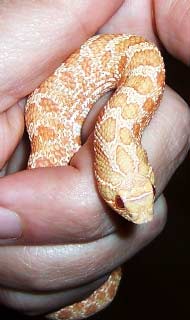 As there are so many different types of Hognose snake, these figures may vary a little depending on the type of Hognose Snake you have, but in general...
As there are so many different types of Hognose snake, these figures may vary a little depending on the type of Hognose Snake you have, but in general...
Description: Hognoses are so called because of their distinctive upturned nose. They use this nose for digging around in soil to unearth the toads and frogs that are their natural prey.
Colouring: Hognose snakes come in a range of colours, but the predominant shade seems to be light brown blotches with a hint of beige in the background. Some Hognoses also have tinges of orange, yellow and grey, depending on the type of Hognose snake you have. Captive breeding has led to a wider variety of colour morphs being available, including the highly sort after albino variety.
Size: Hognoses are a heavy-bodied, stocky snake that will only reach between 1 and 4 ft in adulthood. Females tend to grow larger than Males.
Life Span: 15 years is average for a Hognose Snake in captivity, but it is not uncommon for them to reach 18 years with appropriate care.
Origin: Hognose snakes are native to North America, South America and Madagascar.
Habitat: Hognose snakes are usually found in dry, sandy areas. They are borrowers and like to be able to dig about for food or just to hide away.
Interesting facts about the Hognose Snake
To scare off predators the hognose snake has a cobra-like hood. They are very huffy and puffy snakes who will pretend to be more vicious than they really are, by opening their hood, hissing and striking the threat with a closed mouth.
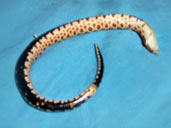 Hognose snakes are especially famous for playing dead when threatened. This is usually after the above display has failed to ward off the thing that is making them anxious, so they play dead to avoid being eaten. This works because there are few creatures in the world that will actually eat carrion. Hognose snakes are great actors and will play dead with great authenticity. They lay on their backs with their mouths open and will even give off a foul smell to make their deception more believable.
Hognose snakes are especially famous for playing dead when threatened. This is usually after the above display has failed to ward off the thing that is making them anxious, so they play dead to avoid being eaten. This works because there are few creatures in the world that will actually eat carrion. Hognose snakes are great actors and will play dead with great authenticity. They lay on their backs with their mouths open and will even give off a foul smell to make their deception more believable.
Another interesting fact about the hognose snake's defensive habits is that once the Hognose snake is playing dead, if you turn it over onto it's front it will instantaneously flip back onto it's back to keep up the charade.
Captive Care
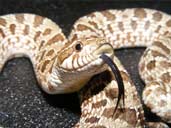 Temperament
Temperament
They have a relatively docile temperament and can be easily tamed. They are energetic and inquisitive and make very interesting pets. They are easy and safe to handle, growing to a manageable size and make a good choice for people who are new to snake keeping.
Hognose snakes are not likely to bite, but it is useful to know that they are mildly venomous. This venom is harmless to humans, as the Hognose snake is rear-fanged and unlikely to bite deep enough to inject. It is believed that the fangs are at the rear of the mouth to help the hognose snake to eat his favourite meal of frogs and toads who often inflate themselves to avoid predators.
Handling
Hognose Snakes are quite active snakes and will appreciate time outside the vivarium to exercise. Hognoses have been known to be a bit huffy, but regular handling should calm your Hognose Snake down in time. They are quite fast little movers, so care should be taken to ensure you do not drop them while being handled.
Shedding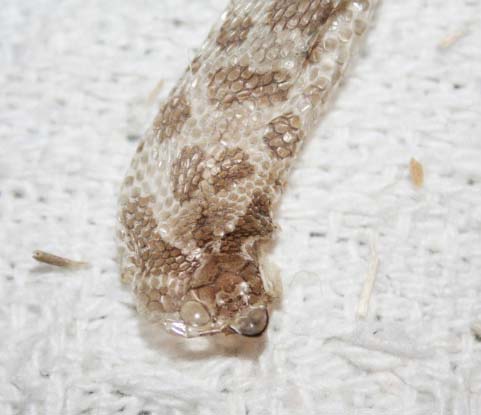
Hognose snakes, like all other snakes, shed their outer layer of skin periodically throughout their lives. Young snakes may shed more frequently than adult snakes, but in general the shedding process occurs several times a year. This is nothing to worry about as a keeper, but there are a few things you can do to help your snake through this process.
Preecdysis is the name given to the changes your snake will go through whilst preparing to shed it's skin. This will include a dulling of your snake's skin colour, general inactivity and their eyes will turn a bluish grey colour. At this time your hognose may refuse a feed or shy away from being handled, but this depends on the individual snake and how they handle preecdysis. While your snake is 'in blue' it is advisable to handle with care as their vision is obscured by the membrane covering it's eyes and they may feel more insecure than usual, therefore more likely to be defensive.
Some snakes will handle a shed without any need for extra help, but if you want to assist your snake during this time you should try to raise the humidity in your Vivarium to help your snake loosen it's skin. You can do this by placing a larger water bowl in the vivarium so that your snake has the opportunity to soak itself if desired. You can also lightly mist the tank with water to help raise the humidity. Another useful tactic is to place a humidity box in the Vivarium. This can be a sandwich box with a hole cut in the top filled with damp sphagnum moss. Your Hognose snake should appreciate the extra humidity and it will make the next stage in the process easier for it.
Ecdysis is the act of shedding, which is usually started by your snake rubbing it's head on rocks or decor to loosen the skin around it's head. Once it has worked it's head free it will continue to crawl its way out of the old skin by rolling it inside out has it moves. Once your snake has shed it's skin it should be removed from the vivarium along with any faeces that usually accompanies Ecdysis. Check your snake to ensure that the shed skin has successfully been removed, taking particular notice that the eyecaps and tail end have not been retained. If necessary bathe your snake and remove any patches of skin that have not been shed with a warm towel or tweezers, to avoid infection or death of the tissue below it.
Feeding
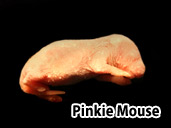 |
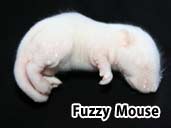 |
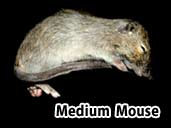 |
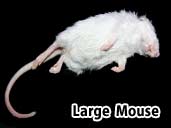 |
Hognose Snakes in the wild will predominantly eat amphibians, with toads making up 50% of their diet. The other half of their diet consists of mice, lizards, turtles, reptile eggs and occasionally carrion. Wild hatchlings may also eat insects.
Captive bred hognose snakes are usually encouraged onto a diet of rodents, since this is a widely available food source. Hatchlings that are reluctant to feed on mice can usually be lured onto the diet by toad or lizard scenting. This involves rubbing or storing the mice with a dead toad or lizard specimen, so that the pinky mouse would gain some of the scent of the other prey item. Do this for a few feeds, then start weaning the hognose off scented-pinkies. This is a very successful trick to get your hognose snake to readily accept rodents as the main part of their diet.
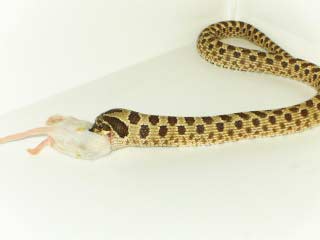 Hatchlings start on pinky mice, one every 5-6 days and graduate up to an adult mouse every 7-10 days as they grow. Very large snakes may require 2 adult mice per feed or even the introduction of larger prey items such as rats. You may also feed a mature Hognose Snakes on hoppers (frozen thawed frogs and toads) to provide a variation in diet, but these may be hard to come by if your local reptile shop does not stock them.
Hatchlings start on pinky mice, one every 5-6 days and graduate up to an adult mouse every 7-10 days as they grow. Very large snakes may require 2 adult mice per feed or even the introduction of larger prey items such as rats. You may also feed a mature Hognose Snakes on hoppers (frozen thawed frogs and toads) to provide a variation in diet, but these may be hard to come by if your local reptile shop does not stock them.
Do not feed your snake with live food, even a small mouse may bite or injure your snake. Shop brought frozen rodents are available from most pet shops or bought over the internet these can be thawed to room temperature and make an excellent all round food for your snake. Wild rodents carry parasites and should be avoided at all times.
Never handle your snake straight after a feed, as it will regurgitate its meal. It is advisable to leave your snake approximately 48 hours to digest their meal before handling.
You can now purchase frozen mice in bulk on Amazon using the links below:
Housing
Hognose Snakes are quite active, but do not need huge enclosures. A medium sized vivarium (Even a fish tank with a tight fitting lid) will house your Hognose nicely. The vivarium should allow a minimum of 1 square foot of floor space to each foot of snake and be approximately a third of the snake’s length in height. Hatchlings should start out in an appropriately sized small faunarium or RUB (Really Useful Box) as they can become stressed and stop feeding in an oversized vivarium.
All Snakes are excellent escape artists, so care must be taken when planning their housing. Make sure your vivarium or tank has a tight fitting lid, which can be clamped down. Hognose Snakes are very strong and can push a loose fitting lid from a vivarium.
Hognose Snakes may grow up to between 1 to 4ft in length, so do not necessarily need a large vivarium. They will feel more secure in a suitably sized vivarium, which should be around 3ftx1ft for an adult, dependant on how big your Hognose Snake grows.
Your Hognose Snake's Vivarium Should Contain:
Substrate
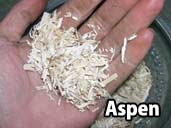 |
 |
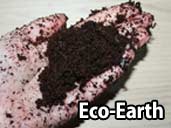 |
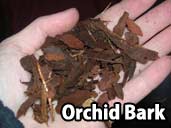 |
With Hognose Snakes, there are a couple of different substrates that can be used:
Aspen Shavings: Aspen shavings may be used for Hognose snakes. The shavings cannot be cleaned and so have to be removed and replaced with fresh shavings when dirty. If you use aspen shavings the urine and faeces can be scooped out with a cat litter scoop, and replaced with fresh shavings as needed. Be sure to remove soiled substrate as soon as possible, as urine-soaked material can become a breeding ground for bacteria, which could harm your snake. It is advisable when using aspen to feed your hognose snake outside the vivarium to avoid the snake ingesting any of the substrate.
At least once a month, all the aspen should be removed and disposed of, and the entire enclosure cleaned and disinfected before new shavings are placed inside.
Newspaper: Layers of newspaper have been used for years in animal keeping. It is relatively absorbent when several layers are used, and inexpensive to replace. However, the inks used in printing are known to be harmful to animals. Unprinted sheets may be obtained at shops selling moving supplies, or roll ends may be obtained from some newspaper companies. As with printed newspaper, it is relatively absorbent when several sheets are used, especially when layered with paper towels. Unlike printed newspaper, the unprinted sheets and rolls are not impregnated with potentially harmful inks that could harm your Hognose.
Paper Towels/Kitchen Roll: Easily obtained and relatively inexpensive, paper towels make an excellent substrate for reptiles with belly injuries and those in the early stages of quarantine.
Eco-Earth
Can be bought in block form and it expands in water to make a rich, reptile safe soil bedding. It is an excellent substrate for your Hognose because it is the perfect consistancy for burrowing. Eco-Earth should be kept relatively dry within your Hognose's vivarium, but can be lightly misted with water if you needed to raise the humidty during the shedding process.
Soil
Hognose snakes can be kept in clean soil, as long as it is fertilizer and chemical free.
Beech Chippings: Beech chippings are not an ideal substrate for Hognose Snakes, because they like to burrow and beech chippings are not the most suitable for this purpose, but it can be used when other substrates are not available. Beech Chippings can be purchased from most Reptile shops and are quite an attractive substrate to have in the vivarium. It comes in three different grades - small, medium or large, so you can choose the size which is most suitable for your snake. It allows for spot cleaning, although it is not as absorbent as Aspen.
Coco/Orchid Bark: Some reptile shops may recommend the use of Coco or Orchid bark for Hognoses, but this substrate is more appropriate for snakes that require higher humidity levels. It is safe to use as long as you monitor the humidity of the vivarium regularly and ensure that your Hognose is comfortable with the conditions.
Astroturf® / Artificial Grass: Astroturf® was the first artificial grass floor covering. Since then, carpet manufacturers have come out with many grades of artificial grass. Hardware shops usually have two or more grades. The least expensive is generally the best to use. It is more flexible, a key factor for thorough cleaning and disinfecting. Pieces can be washed and disinfected repeatedly before they require replacing. Astroturf® is cheap enough that several pieces can be cut for each enclosure and rotated each cleaning day. The pieces of artificial grass substrate sold in small, prepackaged pieces in many pet shops and mail order pet suppliers are the same as the product sold in builder supply shops.
Warning: Do not use Cedar, Pine or Redwood Shavings as these are toxic to most reptiles and should never be used in snake enclosures.
Heating Equipment
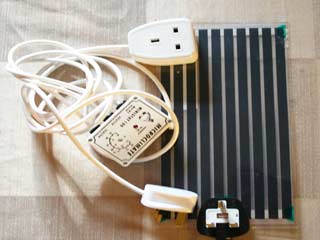 Hognose Snakes are cold blooded and get heat from their surroundings. In the wild snakes bask in the sun to keep warm or move to a shady spot if they are too hot, this is called thermo-regulation. The ideal temperature for you snake's vivarium is a temperature gradient of room temperature at one end up to around 30-33°C (82-85°F) near the heat source.
Hognose Snakes are cold blooded and get heat from their surroundings. In the wild snakes bask in the sun to keep warm or move to a shady spot if they are too hot, this is called thermo-regulation. The ideal temperature for you snake's vivarium is a temperature gradient of room temperature at one end up to around 30-33°C (82-85°F) near the heat source.
Heat should be provided using either a heat mat with thermostat or a bulb with a dimming stat on the roof of the vivarium surrounded by a bulb guard.
Heat mats should only cover between a third and a half of the floor space to allow your snake to thermo-regulate. This heat mat should be regulated by a thermostat to ensure that it does not overheat. Since a heat mat should provide sufficient heat to keep your Hognose snake happy, a basic mat stat, like the Microclimate Ministat 100 or the Habistat Mat Stat (Amazon links below), should be appropriate. These thermostats are available from reptile shops and online, are relatively cheap, and will ensure the heat source is regulated at a safe level.
A popular alternative to the heat mat is a normal light bulb on the roof of the vivarium, attached to a dimming stat. It is important to ensure that the heat source is protected from direct contact with you snake by using a guard. Hognose snakes do not feel heat in the same way that we do and do not always realise that something they are touching is burning them. A bulb guard will ensure that your Hognose snake will stay a safe distance away from the heat of the bulb so burns will be avoided. The disadvantages of using a bulb as a heat source is that the bulb needs to be turned on constantly to keep the vivarium at the correct temperature. Your Hognose snake does not require light 24 hours a day and can suffer from stress if the light exposure is too long. It is recommended to keep your Hognose snake in a natural light pattern that mimics normal daytime, so a heat mat is a better choice between the two heat sources. If you do decide to use a heat mat, then a energy-saving bulb with guard can be added to the vivarium for decorative purposes to help you see your snake.
It's useful when using both methods to have a small thermometer on either end of the vivarium to check the temperature. Place the thermometers near the hides on top of the substrate as this is where your Hognose snake will spend the majority of it's time.One end should be around 33°C and the other around 26°C. Checking temperatures regularly is advised to ensure that your Hognose Snake can thermo-regulate by moving around the tank
Hognose Snakes do not require a U.V lamp in their vivariums, but since they are diurnal (active by day), it might be beneficial to place the vivarium where there is quite a bit of natural light. This should not be direct sunlight, as the glare from the sun might cause the vivarium to become too hot for your snake.
A Place for your Hognose Snake to Hide
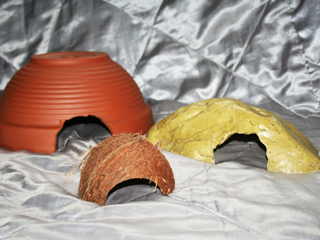 All Hognose Snakes need somewhere to hide and may become stressed if this is not provided. This could be a cardboard box with a hole cut into it, which can be easily replaced if it becomes soiled. Flower pots also make good hides for Hognose Snakes.
All Hognose Snakes need somewhere to hide and may become stressed if this is not provided. This could be a cardboard box with a hole cut into it, which can be easily replaced if it becomes soiled. Flower pots also make good hides for Hognose Snakes.
Specialist reptile hides can be purchased from pet shops and over the Internet. These can be cleaned when you clean the rest of the vivarium once a month.
Any hide should be just large enough for your Hognose Snake to curl up in; if it is too large the snake will not feel as secure.
In general, it is wise to place two hides in your vivarium for your Hognose snake to use, one in the warm side of the vivarium and one in the cooler side. This enables your snake to have adequate hiding places along the temperature gradient, which would allow your snake to adjust its body temperature. This is important, because for some Hognose Snakes, the instinct to hide is often more insistent than the instinct to keep at the right temperature. If the snake does not control his body temperature it can lead to many problems, the least of which being digestive problems.
A Place to Climb
Branches and plastic plants can be bought from pet shops and over the internet these provide a place for climbing and resting, they also aid the snake when shedding its skin. Hognose Snakes appreciate being able to climb, as it will keep them active and provide vital exercise.
Branches collected from the wild will need to be debugged by soaking first in chlorine/water solution, then rinsed thoroughly, soaked in clean water, then left to dry in the sun. Some live plants may be harmful to your Hognose Snake, if in doubt do not use them in your vivarium.
A Change of Scenery
Hognose Snakes are very inquisitive animals and like to explore new surroundings. Once in a while change the layout of the vivarium, as this will keep your Hognose Snake from becoming bored. You will notice once you put your snake back in the tank it will start to re-explore its new surroundings.
Water Bowl
All Hognose Snakes need fresh water to drink daily. Water should be given in a reasonable sized bowl which is fairly heavy to stop your snake tipping it over.
Water can also help your snake during shedding at this time your snake may be found bathing in the water.
If the snake defecates in its water bowl, the bowl must be cleaned and disinfected immediately.
Humidity
Most Hognose snakes do not need to maintain a set humidity level, but some appreciate a light misting of their vivarium occasionally. This is especially useful to raise the humidity during the shedding process.
Eastern or Southern Hognose snakes prefer a higher humidity than other Hognose snakes, but anything around 40-50% should be fine for these two species.
Breeding
Hognose snakes should be of a good age and weight before they are allowed to breed to avoid problems like egg binding. I would recommend that the minimum requirements for a female to breed would be at least 2 years of age, 16 inches in length and 250 grams in weight.
Brumation
Brumation (cooling your snake down for winter) is advised to greater your chances of successful breeding. A good brumation period is about 6 to 8 weeks for both the male and the female hognose. The temperature needs to be dropped gradually to around 14°C/58°F and maintained until gradually raising it back up after the recommended brumation period. Your hognose snake should not be fed during this time, but fresh water should always be available.
Mating
In the wild the Hognose mating season is usually June to August, so this is a good time to introduce your female to the males vivarium for copulation. They can be left together for a few weeks, if you keep feeding them well fed to avoid cannibalism. If the copulation is successful, the female will become gravid (pregnant).
Laying
Once your Hognose snake has become gravid, they will need to fed more frequently to ensure they gain the vital nutrients needed for egg development. A nest box should be placed in the Vivarium when it becomes obvious that the female is searching for a place to lay her eggs. A nest box can be made easily from a plastic tub. Simply cut a hole in the lid of the box that is big enough for your female to fit through and fill the tub with damp vermiculite. Once the eggs have been laid, remove the eggs. Your female will be hungry and exhausted, so continue feeding her more often than you normally would to increase your chances of a successful double clutch.
Incubation
Female Hognoses will lay between 4 and 23 eggs, which will need to be incubated for between 53 and 65 days (6 to 8 weeks). Try to keep the eggs at a constant temperature of 25-27°C/79-81°F. Vermiculite is a good substrate to have inside the incubator as it will help keep the humidity levels correct.
Hatchlings
If incubation is successful the hatchlings should break out of their eggs using an egg tooth. They will remain in the eggs to soak up the york for a few days before venturing out of the shell. You should watch them closely at this stage, but not force them to leave the egg before they are ready.
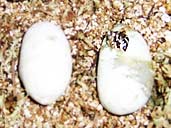 Once they are out of the egg, the hatchlings will all need to be housed separately. Small sandwich box type RUBS (Really Useful Boxes) are good for housing your hatchlings at this stage.
Once they are out of the egg, the hatchlings will all need to be housed separately. Small sandwich box type RUBS (Really Useful Boxes) are good for housing your hatchlings at this stage.
Hatchlings will require their first feed a week after their first shed. If the hatchling is reluctant to eat it's first pinky, try toad scenting or braining the pinky to encourage them to take it. If you are planning to sell on your hatchlings, it is important to ensure that the hatchlings are readily accepting mice as a food source before selling them.
Common Complaints
Hognose Snakes are a hardy snake that would rarely become ill with appropriate care, but here is a quick introduction to a few disorders that need to be looked out for.
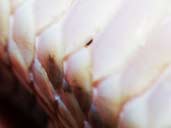 Mites: Mites are little black parasites that live on your Hognose Snake and feed on their blood. If your Hognose Snake catches mites they can usually be found around the eyes, mouth and under scales. Your snake will seem lethargic and may go off it's food during a mite infestation. If you discover mites on your Hognose snake, immediately bathe your snake in warm water and fully disinfect the entire tank and contents. Refill your vivarium with white kitchen roll and leave the cage furniture to a minimum. This helps stops the mites being able to breed as they need substrate to lay eggs and also allows you to see them more clearly while you monitor your snake. Repeated bathing and disinfecting of the vivarium helps, but it unlikely that you will remove a mite infestation without some sort of treatment. Reptile shops sell various treatments to help kill off the mites, but some vets may prescribe a weak dose of Frontline if they feel it is necessary.
Mites: Mites are little black parasites that live on your Hognose Snake and feed on their blood. If your Hognose Snake catches mites they can usually be found around the eyes, mouth and under scales. Your snake will seem lethargic and may go off it's food during a mite infestation. If you discover mites on your Hognose snake, immediately bathe your snake in warm water and fully disinfect the entire tank and contents. Refill your vivarium with white kitchen roll and leave the cage furniture to a minimum. This helps stops the mites being able to breed as they need substrate to lay eggs and also allows you to see them more clearly while you monitor your snake. Repeated bathing and disinfecting of the vivarium helps, but it unlikely that you will remove a mite infestation without some sort of treatment. Reptile shops sell various treatments to help kill off the mites, but some vets may prescribe a weak dose of Frontline if they feel it is necessary.
Respiratory Infections (R.Is): R.Is are a bacterial infection that is usually caused by poor cage conditions, low temperatures or too much humidity, but can be passed from snake to snake too. Hognose Snakes may sound wheezy with excessive saliva and nasal discharge. Their mouths may also gape open as your Hognose struggles to breathe. Very mild R.Is may go away themselves if the conditions that the snake are living in are corrected, but serious infections need to be seen to by a vet immediately to avoid Mouth Rot or even death of your Hognose Snake. The vet may prescribe an anti-biotic called Baytril, which is safe enough to be given to your snake.
Regurgitation: When a snake regurgitates it's meal, it may not necessarily be down to illness, but as regurgitation is a symptom of many digestive problems, illnesses and stress it is recommended that if your Hognose Snake does regurgitate it's meal that you monitor your snake very closely for further symptoms. Sometimes a Hognose Snake may regurgitate it's meal if it is handled too soon after a feeding or if it has been fed an item that is too large for it. In this case, you should leave the snake to settle back down for a week before trying to feed again. If your Hognose Snake repeatedly regurgitates it's meal, loses excessive weight or shows any other signs that are worrying you, seek medical attention as soon as possible.
Further Information
This care sheet is a simple step-by-step guide to successful Hognose keeping, but if you have anymore questions or need more specific information about the keeping of Hognose snakes, please visit our forum. It is a useful resource where you can ask members to share good practice and also talk about your experiences of being a Hognose Snake keeper.

